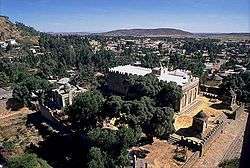Zera Yacob (philosopher)
- This article is about Zera Yacob, the 17th century philosopher. For the Prince, see Zera Yacob Amha Selassie, Crown Prince of Ethiopia. For the emperor, see Zara Yaqob.
Zera Yacob (Ge'ez: ዘርአ:ያዕቆብ zar'ā yāʿiqōb "Seed of Jacob," modern zer'a yā'iqōb; also spelled Zärˀä Yaˁqob, Zar'a Ya'aqob, or Zar'a Ya'eqob; 1599–1692) was a seventeenth-century Ethiopian philosopher. His 1667 treatise, known in the original Ge'ez language as the Hatata, has often been compared by a handful of non-traditional scholars to René Descartes' Discours de la méthode in (1637). His writing came at a period when African philosophical literature was significantly oral in character. He believed in following one's natural reasoning instead of believing what one is told by others.
Biography

Yacob was born into a farmer's family near Aksum in northern Ethiopia, the former capital of Ethiopia under the ancient kingdom of Aksum. Yacob's name means "The Seed of Jacob" ("Zar" is the Ge'ez word for "seed"). Although his father was poor, he supported Yacob's attendance of traditional schools, where he became acquainted with the Psalms of David and educated in the Coptic Christian faith. He was denounced before Emperor Susenyos (r. 1607-1632), who had turned to the Roman Catholic faith and ordered his subjects to follow his own example.
Refusing to adopt the Catholic faith, Yacob fled into exile with some gold and the Book of Psalms. On the road to Shewa in the south, he found a cave at the foot of the Tekezé River and lived in it as a hermit for two years, praying and developing his philosophy. He wrote of his experience, "I have learnt more while living alone in a cave than when I was living with scholars. What I wrote in this book is very little; but in my cave I have meditated on many other such things."
After the death of the Emperor, Susenyos's son Fasiledes (r. 1632-1667), a firm adherent of the Ethiopian Orthodox church, took power, expelling the Jesuits, and extirpated the Catholic faith in his kingdom in 1633. Yacob left his cave and settled in Emfraz. He found a patron, a rich merchant named Habta Egziabher (known as Habtu), and married a maid of the family. He refused to live as a monk and stated that "the law of Christians which propounds the superiority of monastic life over marriage is false and can’t come from God." However, he also rejected polygamy because "the law of creation orders one man to marry one woman."
Yacob became the teacher of Habtu's two sons, and at the request of his patron's son Walda Heywat, Yacob wrote his famous 1667 Treatise investigating the light of reason. Yacob is most noted for this ethical philosophy surrounding the principle of harmony. He purported that an action's morality is decided by whether it advances or degrades overall harmony in the world. His philosophy is theistic in nature. While he did believe in a deity, whom he referred to as God, he rejected any set of religious beliefs. Rather than deriving beliefs from any organized religion, Yacob sought the truth in observing the natural world. In Hatata in following in the footsteps of great church fathers, Yacob applied the idea of the first cause to his proof for the existence of God. "If I say that my father and my mother created me, then I must search for the creator of my parents and of the parents of my parents until they arrive at the first who were not created as we [are] but who came into this world in some other way without being generated." However, the knowability of God does not depend on human intellect, but "Our soul has the power of having the concept of God and of seeing him mentally. God did not give this power purposelessly; as he gave the power, so did he give the reality."
Little is known of Yacob's later life. However, it is believed that he lived a fulfilled family life in Enfraz, and remained there for the next 25 years until he died in 1692. Yacob's year of death was recorded by Walda Heywat in an annotation to the Treatise.
See also
- Walda Heywat, his successor
Further reading
- Teodros Kiros, "Zera Yacob and Traditional Ethiopian Philosophy," in Wiredu and Abraham, eds., A Companion to African Philosophy, 2004.
- Enno Littmann. Philosophi Abessini. Corpus Scriptorum Christianorum Orientalium, Vol. 18, Scriptores Aethiopici, Presses Républicaines, 1904. Contains the Ge'ez text of Zera Yacob's treatise.
- Claude Sumner, Ethiopian Philosophy, vol. II: The Treatise of Zara Yaecob and Walda Hewat: Text and Authorship, Commercial Printing Press, 1976.
- Claude Sumner, Ethiopian Philosophy, vol. III: The Treatise of Zara Yaecob and Walda Hewat: An Analysis, Commercial Printing Press, 1978.
- Claude Sumner. Classical Ethiopian Philosophy, Commercial Printing Press, 1985. Contains an English translation of Zera Yacob's treatise and four other texts.
- Claude Sumner, "The Light and the Shadow: Zera Yacob and Walda Heywat: Two Ethiopian Philosophers of the Seventeenth Century," in Wiredu and Abraham, eds., A Companion to African Philosophy, 2004.
External links
- Brendan Ritchie, "Ethiopian Philosophy: A Brief Introduction with Bibliography and Selections"
- Ethiopian Philosophy - A blog with commentary on Zera Yacob's treatise